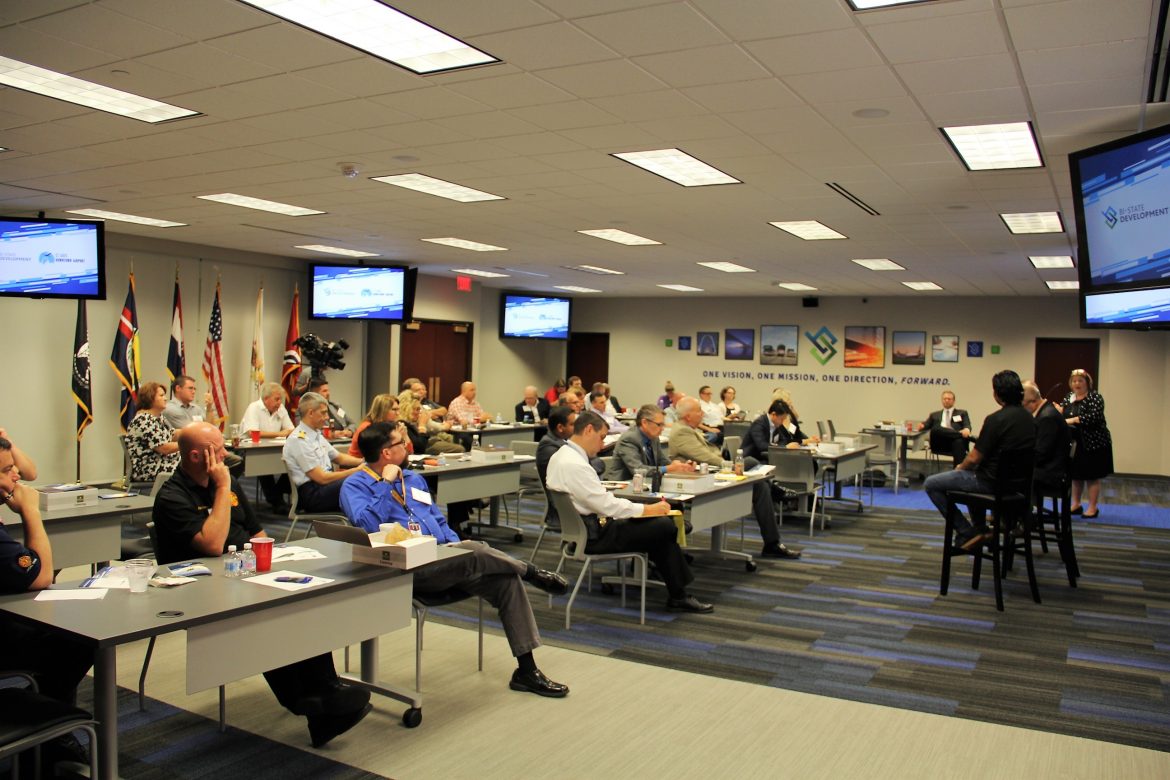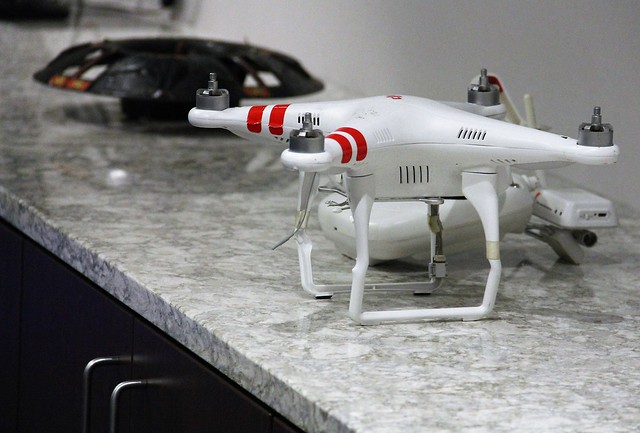
Exploring the Full Potential of Drone Technology
Drones are becoming increasingly visible around the St. Louis region and are being operated by a wide variety of users ranging from construction firms, utility and mining companies and first responders to photographers and hobbyists. Despite the growing popularity of drones, all the potential uses are only beginning to be explored. That was the consensus of a diverse group of business leaders and industry experts who met in St. Louis on September 26 to talk about drones in what was the first of a three-part St. Louis Aviation Industry Forum hosted by Bi-State Development and St. Louis Downtown Airport. The forum aims to take a detailed look at the current and future applications of drones, the unique regulatory issues and challenges they present, and their potential long-term impact on aviation.
The forum highlighted the importance of intentional consideration of how new technology is being utilized in current and future economic development efforts. “Most in this room know drones are not coming; they are already here. But the technology is evolving quickly and many businesses and agencies are in a hurry to incorporate the latest technology at great investment, sometimes without a complete understanding of the challenges and opportunities that unmanned aircraft systems can present,” said Julianne Stone, Bi-State Development Vice President of Strategic Initiatives. “How should we be thinking about the need to realign business models with the perceived or real value of using this technology?”
“Most in this room know drones are not coming; they are already here. But the technology is evolving quickly and many businesses and agencies are in a hurry to incorporate the latest technology at great investment, sometimes without a complete understanding of the challenges and opportunities that unmanned aircraft systems can present,” said Julianne Stone, Bi-State Development Vice President of Strategic Initiatives. “How should we be thinking about the need to realign business models with the perceived or real value of using this technology?”
Panelist Tomislav Žigo, Vice President of Virtual Design and Construction for CLAYCO, talked about how his company was fortunate to be one of the first companies in the United States with permission from the Federal Aviation Administration (FAA) to fly a drone over the perimeter of its construction sites.
“One of the biggest challenges we discovered in using the technology is reconciling the huge amount of information that is being gathered on a construction site,” Žigo said. “If you have a mission that lasts for 30 minutes, you typically gather between 800 and 1500 images that need to be catalogued to be able to extract usable or useful information that I can convey to superintendents, construction managers and project executives and say this is why we fly drones.”
Žigo gave specific reasons as to why CLAYCO flies drones, including: documenting the location of underground utilities; monitoring safety through deployment of artificial intelligence; and helping to eliminate risk aligned with sending someone to inspect different aspects of a job site. However, with insurance requirements and the need to have certified pilots, he cannot put a drone in everyone’s hands.
“I would like to live in an environment where a drone is nothing but just another tool on a work site . . . where every project manager has one drone at their disposal that can provide instantaneous feedback on jobsite conditions. But we are still far away from that capability,” Žigo said. He added that the time between when they acquire information and the time when they translate it into usable feedback to share with the design and construction partners is a critical aspect of their deployment. He believes the software needs to be improved, and storage of all the data is another challenge to be overcome. CLAYCO is committed to drone technology, having created a new company within the organization that is providing a piloting network across the country.
Panelist Ravi Sahu, CEO and Founder of St. Louis-based Strayos, said his company is a drone data backbone software company, analyzing the data collected and processing it into more usable information for their clients that leads to cost savings. Among those are clients in the mining industry who can use drone technology to analyze the geotechnical attributes of a 500-foot tall eye wall without having to send a person to analyze it.
Sahu said how drone data is accessed and how it can be used is key, likening the current rush to embrace drone technology to the period in the 1980s that saw the PC revolution. At that time, the power of massive computing systems suddenly became accessible to smaller businesses who were able to equip individual employees with a personal computer because they instantly saw the business value of the increased productivity it would provide. A similar transition occurred in the late 1990s and early 2000s as people adopted laptops and again more recently with the gravitation to various smart devices.
Sahu said, “We are in the phase now where we are shifting more from this being a revolution to where we’re seeing the technology in use to collect the data, job sites being changed in terms of how the data is analyzed and ultimately, shifting the business model to integrate the technology into existing business models based on the use cases. Among those are the role that drones can play in improving transportation of materials from a mining site.”
“Forty percent of the cost in the mining industry is the transportation. Now there is a better way of understanding where you can send the product or how the route is designed,” said Sahu. “It’s not just what’s being collected but how it’s being integrated into the business model.”
The third panelist, Dr. Srikanth Gururajan, focused on how research can help people choose the appropriate drone for their needs. Gururajan suggested that the performance of the flight controller should be a key factor in selecting a drone to ensure that it is capable of completing the required job safely. Common key considerations for most attendees, many of whom are licensed drone pilot themselves, was the ease of use and the quality of data from the sensor. Gururajan is an Assistant Professor of Aerospace & Mechanical Engineering at Saint Louis University.
“The thing that we do in our lab is to try to evaluate the performance of flight controllers. We are starting to look at how each flight controller performs when you ask it to do the same task on the same flight path. It goes back to making sure that your platform is the right fit,” said Gururajan.
Existing available drone technology is already making a difference in some first responder operations in the St. Louis area. Attendee Matt Pagano, a paramedic and firefighter with University City Fire Department who also serves as the department’s drone coordinator, said the University City Fire Department launched its drone program earlier this year, and already has six drones and six pilots 107 certified to fly them. He said the drones are being used to get a bird’s eye view when a fire is underway to help provide valuable information to influence firefighting efforts.
Looking to the future, all the panelists see great potential for drone technology to be used more widely to deliver products in a better way, deliver a safer job site, or even deliver an entirely new commuting experience, but they agree it will take more collaboration to get there. The collaboration will need to involve the companies that can help to efficiently leverage the vast amounts of data the drones can gather, and the regulatory agencies that manage what moves through the air spaces. Erick Dahl, director of St. Louis Downtown Airport, explained airports do not have control over drones, but rather it is Air Traffic Control, something that will likely be discussed further in future forums.
The next forum session is scheduled for October 11 and will look at issues to consider for local regulation. The third and final forum in the series will take place on October 24 and will examine the integration of drones in the general and commercial aviation landscape. To learn more, visit Details And Registration or contact Julianne Stone at or Erick Dahl.
About Bi-State Development
Bi-State Development (BSD) owns and operates St. Louis Downtown Airport and the Gateway Arch Riverboats, as well as operates the Gateway Arch Revenue Collections Center and Gateway Arch trams. BSD is the operator of the Metro public transportation system for the St. Louis region, which includes the 87 vehicle, 46-mile MetroLink light rail system; a MetroBus vehicle fleet of approximately 400 vehicles operating on 79 MetroBus routes; and Metro Call-A-Ride, a paratransit fleet of 120 vans. BSD also operates the Bi-State Development Research Institute and the St. Louis Regional Freightway, the region’s freight district.

